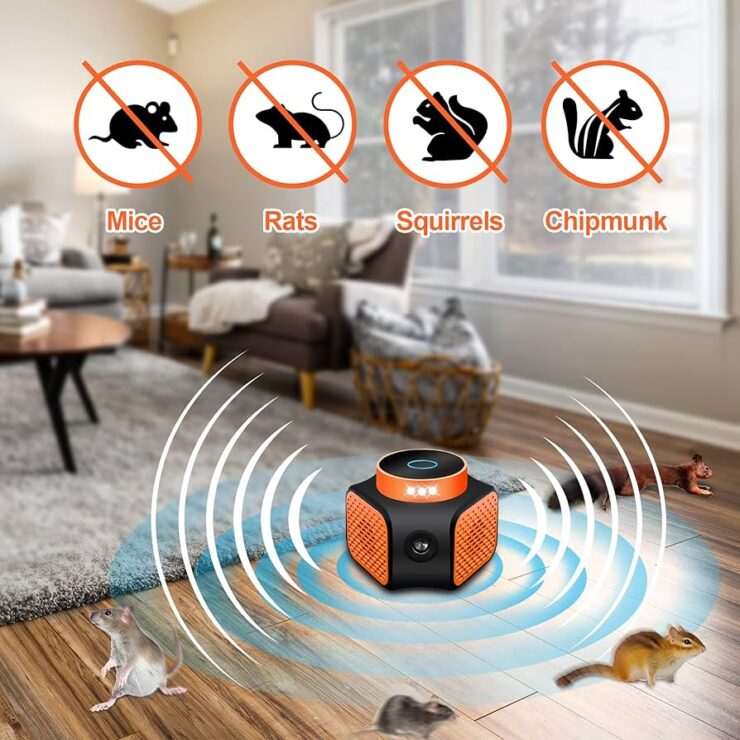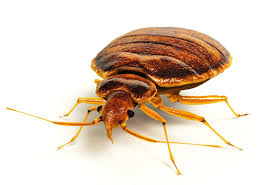Key Highlights
- Ultrasonic pest repellers are devices that produce high-frequency sound waves, inaudible to humans, intended to deter pests.
- They target common household pests like rodents, insects, and spiders.
- Effectiveness is debatable, with mixed scientific evidence and anecdotal success stories.
- Concerns exist regarding potential impacts on pets, particularly those with sensitive hearing, like rodents and some dog breeds.
- Alternative pest control methods like traps, baits, and professional services often prove more reliable.
Introduction
Are you dealing with unwanted guests in your home? Ultrasonic pest repellers can seem like an easy and hidden way to control pests. These devices claim to be safe and effective. They use ultrasonic sound waves that people cannot hear to keep pests away. But the big question is: do ultrasonic pest repellers work like they say they do?
Table of Contents
Understanding Ultrasonic Pest Control
Ultrasonic pest control uses high-frequency sound waves that are above 20,000 Hz. This level is out of the range of human hearing. These devices can come in different styles, like plug-in units or battery-operated versions. They give off sounds to make pests uncomfortable, which should drive them away.
The idea is that these ultrasonic sounds disturb a pest’s ability to navigate, communicate, and find food. Manufacturers often say these sounds annoy or confuse the pests, making the treated area less appealing for them. However, it’s important to look at the science and user feedback to get a complete view of how effective these devices really are.
The Principle Behind Ultrasonic Pest Repellers
Ultrasonic pest repellers work by using sound waves that people cannot hear. These special sound waves, called ultrasonic sound waves, are emitted by the device and move through the air.
Humans do not hear these ultrasonic frequencies, but many pests, such as rodents and insects, can hear them well. The idea is that these strong sound waves create a strange feeling for the pests. This feeling makes them want to leave the area where the device is working.
Manufacturers say that the uncomfortable sound waves interfere with pests’ normal behavior, including their habits of feeding, mating, and communicating. Because of this, pests will look for a better place to live, which keeps them away from the area treated by the ultrasonic pest repellers.
Types of Pests Targeted by Ultrasonic Devices
Ultrasonic pest repellers are often sold as a way to deal with different household pests. These devices mainly focus on rodents, like mice and rats, because they can hear high-frequency sounds very well.
Insects are also a common target. People say these devices work against mosquitoes, cockroaches, ants, and spiders. The devices claim to confuse these pests, which makes it hard for them to live in the area where the repeller is used. However, it’s key to know that how well ultrasonic repellers work on insects can change based on the insect type.
Some personal stories show that they might work sometimes, but scientific studies about the effects of ultrasonic frequencies on various insect types are still unclear.
Effectiveness of Ultrasonic Pest Control
The success of ultrasonic pest control has sparked a lot of discussion. Some users say it works well and they see fewer pests. But many scientists are not convinced. Several studies have looked into ultrasonic pest repellers, and the results are mixed.
Some research shows that certain pests might stay away from areas with high-frequency sounds at first. However, this effect usually doesn’t last long. Eventually, pests can get used to the sound, making the device no longer work. Also, the effectiveness of ultrasonic repellers can depend on the type of pest, the setting, and where the device is placed.
Scientific Evidence Supporting Ultrasonic Pest Repellers
Scientific studies investigating the effectiveness of ultrasonic pest repellers have produced varied and often contradicting results. While some researchers observed a degree of pest avoidance with certain frequencies, the overall consensus within the scientific community is that these devices lack consistent efficacy as a standalone pest control solution.
The University of Arizona conducted a comprehensive review of sonic pest repellent studies. While their findings acknowledge some documented success in controlled environments using specifically targeted frequencies, they generally caution against relying solely on commercial ultrasonic repellers for pest management.
Similarly, a 2002 study by Kansas State University evaluating the impact of three different ultrasonic repeller models on ant populations found no significant repellency. Such studies highlight the limitations and inconsistencies associated with ultrasonic pest control technology.
| Study | Institution | Pest | Findings |
| Levin, R. B., et al. (2002) | Kansas State University | Ants | No significant repellency observed. |
| Cranshaw, W. S. (2012) | University of Arizona | Bed bugs | Four different models tested; no noticeable effect on bed bug activity. |
Limitations and Factors Influencing Efficacy
Many marketing claims about ultrasonic pest repellers are not fully true. Several limitations and environmental factors affect how well they work. One big issue is that ultrasonic sound waves have a limited range. Things like furniture and walls can easily absorb or block these waves. Because of this, it is hard to cover large rooms or areas effectively.
Another problem is that pests might adapt to the ultrasonic sound. Just like people get used to background noise, pests may not respond to these sounds over time, making the repeller less effective.
The Federal Trade Commission (FTC) has raised concerns about some claims made by ultrasonic pest repeller companies. They found that there is not enough scientific evidence to back up these claims. Because of this, the FTC has taken action against some companies that say their products work better than they actually do.
Comparing Ultrasonic Pest Control with Traditional Methods
Ultrasonic pest control is one choice among many for dealing with unwanted pests in homes. It looks appealing because it is eco-friendly and easy to use. However, it is important to consider how well it works compared to traditional pest control methods.
Traditional pest control includes different ways, like chemical pesticides, traps, baits, and hiring exterminators. Each method has its benefits and downsides. Homeowners need to think about things like cost, safety, and how bad the pest problem is before making a choice.
Advantages of Ultrasonic Pest Repellers Over Chemicals
Ultrasonic pest repellers have some clear benefits compared to traditional chemical pesticides. One big plus is that they are non-toxic. This means they do not use harmful chemicals that can stay in the environment or hurt children and pets. Because of this, they are a safer choice for families worried about exposure to chemicals.
Another advantage is that they are easy to use. Unlike chemical pesticides that need mixing, spraying, or spreading, ultrasonic repellers usually just plug in and go. This convenience attracts homeowners who want an easy way to control pests.
Ultrasonic repellers are also seen as a more humane way to deal with pests. They work by deterring pests instead of killing them.
- Non-toxic: Safe for children, pets, and the environment.
- Easy to use: Plug-and-play operation requires minimal setup or maintenance.
- Humane approach: Aims to deter pests without directly killing them.
Situations Where Traditional Pest Control Is Preferable
While ultrasonic pest repellers can look good, some situations need real help from expert pest control. When pest numbers get very high, seeing a professional pest control service is often needed.
Skilled pest control technicians know how to check how bad the problem is. They can spot the type of pest you are dealing with and make a specific pest control plan.
If you face pests that can harm your health or damage property, like termites, rodents, or stinging insects, just using ultrasonic repellers may not be enough. In these cases, professional pest control services are a better choice.
- Severe infestations: Experts can easily handle large pest problems.
- Health hazards: Some pests need special care to reduce health risks.
- Property damage: To stop pests like termites, you need skilled help to avoid more damage.
User Experiences and Case Studies
User experiences with ultrasonic pest repellers vary widely. Online reviews show mixed results. Some people say these devices work, while others are not happy with them. This difference in experiences shows that ultrasonic pest control can be unpredictable and depends on personal opinions.
Some users have noticed fewer pests after they started using the ultrasonic repellers. They report seeing fewer rodents and having fewer problems with insects. However, it can be hard to say that these changes are only because of the devices. Other things, like changes in the weather or better cleaning habits, might also be influencing these results.
Success Stories of Ultrasonic Pest Control
A look at online customer reviews shows many success stories linked to ultrasonic pest repellers. Homeowners dealing with small pest issues, like seeing occasional spiders or mice, often share good experiences. They say they notice fewer pests after using these devices.
Many people use the repellers to prevent pests or mix them with other pest control methods. For example, some users team ultrasonic repellers with regular cleaning and closing up entry points. This helps make their homes less inviting to pests.
However, we should be careful when reading these stories. They might show real positive outcomes, but we need to think about other factors. Different things can affect how well the devices work, like the type of pests, the environment, and the specific ultrasonic device used.
Challenges Faced by Users
Some users like ultrasonic pest repellers, but others have faced problems. A typical complaint is that some makers make big promises about how well their devices work.
People who buy these repellers expecting to get rid of all pests often feel let down. Some users have also seen their ultrasonic pest repellers mess with other electronic devices at home.
For example, they have experienced disruptions in telephone calls or problems with electronic devices because of the repellers. Our editorial team could not check these claims directly, but they raise worries about possible issues with compatibility.
Safety Concerns with Ultrasonic Pest Repellers
Ultrasonic pest repellers are generally safer than chemical pesticides, but they can still raise some safety concerns. They produce high-frequency sounds that people cannot hear. However, there are questions about how these sounds might affect pets. This is especially important for animals with sensitive hearing, like dogs and cats, as well as small pets such as hamsters and gerbils.
Some people worry that ultrasonic frequencies could cause distress or discomfort to these animals. While there needs to be more research on this topic, it’s smart to be cautious. Consider the possible risks if you have pets at home.
Impact on Pets and Non-Target Wildlife
Manufacturers often say that ultrasonic pest repellers are safe for humans and pets. However, there are still worries about how they might affect certain animals. This is especially true for animals with sensitive hearing. Small rodents like guinea pigs and hamsters can be harmed by high-frequency sounds. These sounds can lead to stress, anxiety, and might even damage their hearing.
If you have these pets, it’s best not to use ultrasonic repellers near them. Also, while these devices are meant to target specific pests, the ultrasonic sounds could impact other wildlife. This includes bats, birds, and helpful insects that help with natural pest control.
We still do not know much about the long-term effects of using ultrasonic repellers widely. This highlights the importance of using responsible and informed methods for pest control.
Long-term Safety for Humans
Manufacturers of ultrasonic pest repellers create their devices to produce sounds that humans cannot hear. In theory, these sounds should not cause harm to people.
But, some people who are sensitive to sound or have been around high-frequency sounds for a long time could feel discomfort or temporary issues with hearing. There is no strong proof linking ultrasonic pest repellers to long-term health problems in humans. Still, more studies are needed to check for any risks that may come from being around these sounds for a long time.
To be safe, it’s best to keep these devices away from places where people sleep or stay for a long time, especially if they already have sensitive hearing.
Does Ultrasonic Pest Control Work?
Using ultrasonic pest control is still debated. There is scientific evidence that supports its effectiveness for some pests, but limitations and factors can affect how well it works. Ultrasonic pest repellers have some benefits over traditional pest control methods. They are safer and better for the environment. However, there are times when people might prefer using standard pest control. People have different experiences; some have success stories, while others face challenges. We should also think about safety issues, like how they may affect pets and the long-term safety of humans, when picking ultrasonic pest control methods. If you have any questions or need help, please contact us.
Ready to Take Action Against Pests?
Don’t let pests take over your home or business. Contact Pest Pro Now for a free consultation and let our local experts create a customized plan to keep your property pest-free. Find your nearest location here and take the first step toward a pest-free environment today!
Frequently Asked Questions
How long before I can see results with ultrasonic pest repellers?
The time it takes to see results with ultrasonic devices can change a lot. Some homeowners notice less pest activity in just a few days or weeks. Others, however, may not see any big difference. It’s important to keep your expectations realistic. These devices are not quick fixes.
Can ultrasonic pest repellers drive away all types of pests?
No, ultrasonic pest repellers do not work for every household pest. These devices may keep some common pests away, but they do not work for all types. How well an ultrasonic repeller works depends on the kind of pest, the frequency of the device, and the surrounding area.
What are the advantages and disadvantages of using ultrasonic pest control devices?
Ultrasonic pest repellers can be helpful since they are safe and simple to use. But, they may not work well all the time. They have a small range and can bother pets. Also, their long-term safety is not yet proven, which are important things to consider.
Are there any studies or research that support the effectiveness of ultrasonic pest control?
Scientific studies on ultrasonic pest control have had mixed results. Some studies suggest that ultrasonic methods may work against certain pests in controlled settings. However, others find no real effects. More research is needed to confirm how effective these methods are.




Add comment